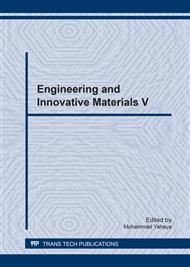[1]
B. Pekmezci and S. Akyuz: Optimum usage of a natural pozzolan for the maximum compressive strength of concrete. Cement and Concrete Comp Vol. 34 (2004), p.2179.
DOI: 10.1016/j.cemconres.2004.02.008
Google Scholar
[2]
A.A. Almusallam, H. Beshr, M. Maslehuddin and O.S.B. Al-Amoudi: Effect of silica fume on the mechanical properties of low quality coarse aggregate concrete. Cement and Concrete Comp Vol. 26 (2004), p.900.
DOI: 10.1016/j.cemconcomp.2003.09.003
Google Scholar
[3]
M. Mazloom, A.A. Ramezanianpour and J.J. Brooks: Effect of silica fume on mechanical properties of high-strength concrete. Cement and Concrete Comp Vol. 26 (2004), p.357.
DOI: 10.1016/s0958-9465(03)00017-9
Google Scholar
[4]
S. Bhanja and B. Sengupta: Influence of silica fume on the tensile strength of concrete. Cement and Concrete Res Vol. 35 (2005), p.747.
DOI: 10.1016/j.cemconres.2004.05.024
Google Scholar
[5]
D.D. Bui, J. Hu and P. Stroeven: Particle size effect on the strength of rice husk ash blended gap-graded Portland cement concrete. Cement and Concrete Comp Vol. 27 (2005), p.366.
DOI: 10.1016/j.cemconcomp.2004.05.002
Google Scholar
[6]
A. Naji Givi, S.A. Rashid, F.N.A. Aziz and M.A.M. Salleh: Assessment of the effects of rice husk ash particle size on strength, water permeability and workability of binary blended concrete. Constr. Build. Mater Vol. 24 (2010), p.2150.
DOI: 10.1016/j.conbuildmat.2021.122929
Google Scholar
[7]
K, Sakr: Effects of silica fume and rice husk ash on the properties of heavy weight concrete. J. Mater. Civil Eng Vol. 18 (2006), p.376.
DOI: 10.1061/(asce)0899-1561(2006)18:3(367)
Google Scholar
[8]
A.L.G. Gastaldini, G.C. Isaia, N.S. Gomes and J.E.K. Sperb: Chloride penetration and carbonation in concrete with rice husk ash and chemical activators. Cement and Concrete Comp Vol. 29 (2007), p.180.
DOI: 10.1016/j.cemconcomp.2006.11.010
Google Scholar
[9]
M.A. Megat Johari, J.J. Brooks, S. Kabir, P. Rivard: Influence of supplementary cementitious materials on engineering properties of high strength concrete. Constr. Build. Mater Vol. 25 (2011), p.2648.
DOI: 10.1016/j.conbuildmat.2010.12.013
Google Scholar
[10]
J.J. Brooks and M.A. Megat Johari: Effect of metakaolin on creep and shrinkage of concrete. Cement and Concrete Comp Vol. 23 (2001), p.502.
DOI: 10.1016/s0958-9465(00)00095-0
Google Scholar
[11]
B.H. Abu Bakar, P.J. Ramadhansyah and M.J. Megat Azmi: Effect of rice husk ash fineness on the chemical and physical properties of concrete. Mag. Concrete Res Vol. 63 (2011), p.320.
DOI: 10.1680/macr.10.00019
Google Scholar
[12]
S.J. Dewi, P.J. Ramadhansyah, A.H. Norhidayah, M.R. Hainin and W.I. Mohd Haziman: Effect of rice husk ash fineness on the properties of concrete. Appl. Mech. Mater Vol. 554 (2014), p.207.
DOI: 10.4028/www.scientific.net/amm.554.203
Google Scholar
[13]
P.J. Ramadhansyah, B.H. Abu Bakar, M.J. Megat Azmi and M.H. Wan Ibrahim: Engineering properties of normal concrete grade 40 containing Rice husk ash at different grinding times. Int. J. Technol Vol. 2 (2011), p.19.
DOI: 10.2478/v10077-011-0001-0
Google Scholar
[14]
M.H. Wan Ibrahim, N. Jamaludin, J.M. Irwan, P.J. Ramadhansyah and A. Suraya Hani: Compressive and flexural strength of foamed concrete containing polyolefin fibers. Adv. Mater. Res Vol. 911 (2014), p.493.
DOI: 10.4028/www.scientific.net/amr.911.489
Google Scholar
[15]
E. Jusli, H.M. Nor, R.P. Jaya and Z. Haron: Strength and microstructure properties of double layered concrete paving blocks containing waste tyre rubber granules. J. Teknologi Vol. 73 (2015), p.90.
DOI: 10.11113/jt.v73.4294
Google Scholar
[16]
M.R. Hainin, M.Y. Matori and O.E. Akin: Evaluation of factors influencing strength of foamed bitumen stabilised mix. J. Teknologi Vol. 70 (2014), p.119.
DOI: 10.11113/jt.v70.3499
Google Scholar


